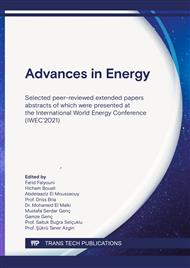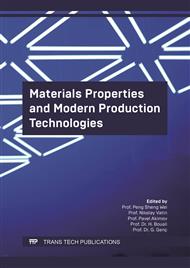[1]
P. Harrison, A. Valavanis, Quantum Wells, Wires and Dots: theoretical and computational physics of semiconductor nanostructures, John Wiley & Sons (2016).
DOI: 10.1002/9781118923337
Google Scholar
[2]
A.V. Zvelindovsky, Nanostructured soft matter: experiment, theory, simulation and perspectives, Springer Science & Business Media (2007).
Google Scholar
[3]
Y. Li, F. Qian, J. Xiang, Charles M.lieber, Nanowire electronic and optoelectronic devices, Materials today 9 (2006) 18-27.
DOI: 10.1016/s1369-7021(06)71650-9
Google Scholar
[4]
L. Jacak, P. Hawrylak, A. Wojs, Quantum Dots, Springer, Berlin (1998).
Google Scholar
[5]
A. El Moussaouy, N. Ouchani, Y. El Hassouani, A. Benami, Bound polaron states in GaAs/Ga1-xAlxAs cylindrical dot under hydrostatic pressure effect, Surf. Sci. 624 (2014) 95–102.
DOI: 10.1016/j.susc.2014.02.005
Google Scholar
[6]
L. Belamkadem, O. Mommadi, J.A. Vinasco, D. Laroze, A. El Moussaouy, M. Chnafi, C.A. Duque, Electronic properties and hydrogenic impurity binding energy of a new variant quantum dot, physica E 126 (2021) 114642.
DOI: 10.1016/j.physe.2021.114642
Google Scholar
[7]
Z. Zeng, C.S. Garoufalis, A.F. Terzis, S. Baskoutas, Linear and nonlinear optical properties of ZnO/ZnS and ZnS/ZnO core shell quantum dots: Effects of shell thickness, impurity, and dielectric environment, J. Appl. Phys. 114 (2013) 023510.
DOI: 10.1063/1.4813094
Google Scholar
[8]
X. Peng, P. Logan, Electronic properties of strained Si/Ge core-shell nanowires, Appl. Phys. Lett. 96 (2010) 143119.
DOI: 10.1063/1.3389495
Google Scholar
[9]
A.C. Bartnik, F.W. Wise, A. Kigel, E. Lifshitz, Electronic structure of PbSe/PbS core-shell quantum dots, Phys. Rev. B 75 (2007) 245424.
Google Scholar
[10]
Y. Nandan, Mohan, S. Mehata, Wavefunction Engineering of Type-Ⅰ/Type-Ⅱ Excitons of CdSe/CdS Core-shell Quantum Dots, Sci. Rep. 9 (2019) 1-11.
DOI: 10.1038/s41598-018-37676-3
Google Scholar
[11]
A.D. Lad, P.P. Kiran, D. More, G.R. Kumar, S. Mahamuni, Two-photon absorption in ZnSe and ZnSe/ZnS core/shell quantum structures, Appl. Phys. Lett. 92 (2008) 043126.
DOI: 10.1063/1.2839400
Google Scholar
[12]
A. Chafai F. Dujardin I. Essaoudi A. Ainane, Energy spectrum of an exciton in a CdSe/ZnTe Type-Ⅱ core/shell spherical quantum dot, Superlattice. Microstruct. 101 (2017) 40-48.
DOI: 10.1016/j.spmi.2016.11.017
Google Scholar
[13]
H. Sun, B.C. Liu, and Q. Tian, Polaron effects in cylindrical GaAs/AlxGa1-xAs core-shell nanowires, Chin. Phys. B 26 (2017) 097302.
DOI: 10.1088/1674-1056/26/9/097302
Google Scholar
[14]
A. El Moussaouy, N. Ouchani, Y. El Hassouani, D. Abouelaoualim, Temperature and hydrostatic pressure effects on exciton-phonon coupled states in semiconductor quantum dot, Superlattice. Microstruct.73 (2014) 22-37.
DOI: 10.1016/j.spmi.2014.05.006
Google Scholar
[15]
O. Mommadi, A. El Moussaouy, M. El Hadi, A. Nougaoui, Excitonic properties in an asymmetric quantum dot nanostructure under combined influence of temperature and lateral hydrostatic pressure, Mater. Today: Proc. 13 (2019) 1023–1032.
DOI: 10.1016/j.matpr.2019.04.067
Google Scholar
[16]
O. Mommadi, A. EL Moussaouy, M. Chnafi, M. El Hadi, A. Nougaoui, H. Magrez, Exciton-phonon properties in cylindrical quantum dot with parabolic confinement potential under electric field, Physica E 118 (2020) 113903.
DOI: 10.1016/j.physe.2019.113903
Google Scholar
[17]
R. Betancourt-Riera, R. Betancourt-Riera, L.A. Ferrer-Moreno, A.D. Sañu-Ginarte, Theory of electron Raman scattring in a semiconductor core/shell quantum well wire, Physica B 563 (2019) 93–100.
DOI: 10.1016/j.physb.2019.04.004
Google Scholar
[18]
O. Mommadi, A. El Moussaouy, M. El Hadi, M. Chnafi, Y. M. Meziani, C. A. Duque, Stark shift and exciton binding energy in parabolic quantum dots: hydrostatic pressure, temperature, and electric field effects, Philos. Mag. 101 (2021) 753-775.
DOI: 10.1080/14786435.2020.1862430
Google Scholar
[19]
G.O. Eren, S. Sadeghi, H. B. Jalali, M. Ritter, M. Han, I. Baylam, R. Melikov, A. Onal, F. Oz, M. Sahin, C.W. Ow-Yang, A. Sennaroglu, R.T. Lechner, S. Nizamoglu ACS Applied Materials & Interfaces 13 (2021), 32022-32030.
DOI: 10.1021/acsami.1c08118
Google Scholar
[20]
E. B. Al, Effect of magnetic field, size and donor position on the absorption coefficients related a donor within the core/shell/shell quantum dot. Opt. Quant. Electron. 53, 676 (2021).
DOI: 10.1007/s11082-021-03340-w
Google Scholar



